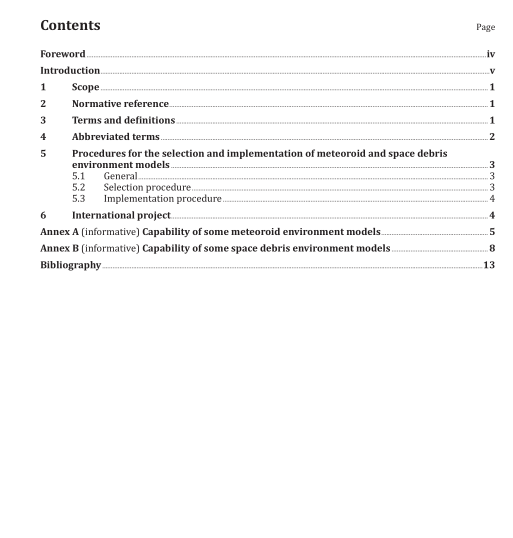ISO 14200:2021 pdf download.Space environment (natural and artificial) — Process-based implementation of meteoroid and debris environment models (orbital altitudes below GEO + 2 000 km)
This document specifies a common process for selecting and implementing meteoroid and space debris environment models used in the impact flux assessment for design and operation of spacecraft and other purposes. This document provides guidelines and requirements for the process.
2 Normative reference
There are no normative references in this document.
3 Terms and definitions
For the purposes of this document, the following terms and definitions apply.
ISO and IEC maintain terminological databases for use in standardization at the following addresses:
— ISO Online browsing platform: available at https:// www .org/ obp
— IEC Electropedia: available at http:// www .electropedia .org/
3.1 impact flux
number of impacts per unit area per unit time
3.2 mass density
mass per unit volume
3.3 meteoroid
small celestial body of natural origin
Note 1 to entry: Generally, a meteoroid is a solid, rocky object of a size considerably smaller than an asteroid and considerably larger than an atom.
Note 2 to entry: It is thought that most meteoroids result from the disintegration and fragmentation of comets and asteroids orbiting the sun, whereas others are collision impact debris ejected from bodies such as the Moon or Mars.
3.4 meteoroid environment model
type of analysis model that computationally simulates the meteoroid (3.3) population orbiting the sun Note 1 to entry: Typically, this type of model is used to predict the flux of meteoroids on a target object in space,such as a spacecraft.
4 bbreviated terms
AU astronomical units
CME chemistry of meteoroid experiment
ESA European Space Agency
EuReCa European retrievable carrier
GEO geostationary earth orbit
GUI graphical user interface
HAX haystack auxiliary radar
HST-SA Hubble space telescope solar array
HST (SM1) Hubble space telescope (service mission 1)
HST (SM3B) Hubble space telescope (service mission 3B)
IMEM interplanetary meteoroid engineering model
ISS international space station
LDEF long duration exposure facility
LEO low earth orbit
MASTER meteoroid and space debris terrestrial environment reference
5 Procedures for the selection and implementation of meteoroid and space
debris environment models
5.1 General
Meteoroid and space debris environment models can be used to estimate the impact fluxes of meteoroids and space debris on a spacecraft. This flux information can be used in
a) the selection of the spacecraft operation orbit in mission analysis,
b) the evaluation of the safety of specific orbit(s),
c) the prediction of the frequency of collision avoidance operations, and
d) the design of suitable impact protection, especially for critical components.
There is a variety of environment models available, each with its own set of characteristics and capabilities. 5.2 and 5.3 specify procedures that are available to guide a user in the selection and implementation of a suitable model.
5.2 Selection procedure
5.2.1 The customer and the supplier of the spacecraft shall coordinate in selecting the meteoroid and space debris environment models that are applied to their project and agree to the conclusion.
5.2.2 To select a suitable environment model, the capabilities of available candidate models should be considered.
NOTE Annex A describes the capabilities of some meteoroid environment models and Annex B describes the capabilities of some space debris environment models.
5.2.3 Models other than those listed in Annexes A and B may be used.
5.2.4 When selecting an environment model, the following should be considered:
a) transparency of the characteristics of the model;
b) whether the model is used by a national space agency;
c) whether the model is maintained on a regular and frequent basis;
d) the format of the output flux data, including its suitability for transfer to another model, such as an impact risk analysis code;
e) the ease of use of the model.
5.2.5 When selecting an environment model, consideration should be given to the fact that there can be significant differences in the calculated fluxes among the available candidate models. The customer and/or the supplier should compare the fluxes of several models. See A.3 and B.3.ISO 14200 pdf download.
